Industry News
Study of forced labor risk in U.S. food supply provides stepping stone for future action
TweetJul. 28, 2023
By:
Pietro N. Bianchi
An academic study written by professors at Tufts University and the University of Nottingham
assessing the risk of forced labor in the U.S. food supply was published on July 24 in the online journal Nature Food. The study combined data on production, trade, labor intensity, and qualitative risk coding to quantify the risk of forced labor in the U.S. food supply chain (excluding seafood). Of the 212 food products and 1,312 product–country combinations assessed, 41% were unprocessed food products, 48% included one stage of processing, 8% had two stages, and 3% had three stages. Processed products were mapped to estimated origin countries of inputs.

The study found that the three categories with the highest forced labor risk were meat, poultry, and eggs; other products, which includes ‘discretionary foods’ such as sweeteners, coffee, beer, wine, and chocolate and cocoa; and processed fruits and vegetables. Disproportionately high-risk foods included boneless beef for meats; fruits such as avocados, lemons and limes, and pineapples; and vegetables such as tomatoes and chilies and peppers.
The study commended trade sanctions role in combating forced labor but concluded that import controls should be just one part of a larger strategy that includes national and local regulation, monitoring, and enforcement to mitigate domestic risk. This is because 51% of the total risk of forced labor risk was attributed to the United States. The fact that the majority of U.S. food is sourced domestically and an overreliance on low-income migrant workers, which are vulnerable to exploitation due to undocumented status or immigration programs, were cited as reasons for the high figure. The second and third highest contributing countries to forced labor risk were China at 13% and Mexico at 8% of the total risk.
Processed products are of particular concern for domestic producers and importers alike. Apple juice concentrate illustrates how the nature of products may create risk. The study states that it takes 10 tons of apples to make one ton of concentrate. The volume needed to produce the concentrate and high reliance on imports from China makes it the third riskiest processed food.
Further, products with two stages of processing and inputs from many origin countries, such as cocoa powder/cake and refined sugar, can pose disproportionately high risk. Input materials from one country may be mixed with those from another country and stages of production often occur in different countries. Processing an input may change its origin for customs purposes (U.S. or otherwise). The result is that a single package cocoa powder imported into the U.S. may consist of inputs from almost a dozen countries.
In sum, the report concludes that goods that have multiple stages of production, inputs potentially from high-risk countries, and requiring voluminous inputs to produce pose a higher risk that forced labor is in their supply chain. To the extent these risks arise with imported goods, rather than within the United States, importers may want to map out their supply chains before CBP targets one (or more) of their input materials.
If you have questions about forced labor concerns, supply chain assessments, or country of origin do not hesitate to contact an attorney at Barnes Richardson, & Colburn LLP.
